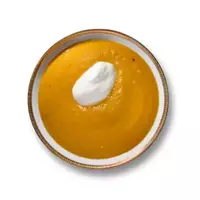Pumpkin puree

Since childhood, we have known pumpkin and not only thanks to Charles Perot's fairy tale Cinderella. The genus of herbaceous plants Pumpkin is represented by a species called common pumpkin or Cucurbita pepo. Pumpkin refers to herbaceous plant species that may be annual or perennial. The pumpkin usually blooms in large yellow or white flowers. The plant clings to soil or other plants using antennae that are located on the pumpkin stem.
The fruit of the plant is called pumpkin. Inside the pumpkin contains orange or yellow flesh, as well as seeds of the plant. There are about 20 major varieties of the pumpkin plant that are native to various climatic zones in both hemispheres of the earth. In addition, in addition to edible, decorative subspecies of pumpkin are grown. Pumpkin fruits are eaten and also used as pet food. Humanity has long been familiar with the useful properties of pumpkin, so the product took a worthy place in the global culinary tradition.
Usually, porridge, soups, or pumpkin puree are made from the flesh of the fruit. Baked pumpkin fruits are especially popular. As you can see from the pumpkin, you can get not only a magic carriage for Cinderella or an intimidating candlestick for Halloween, but also delicious, as well as nutritious dishes. Pumpkin contains a sufficient amount of vitamins of group A, C, E, PP, B, as well as D and F. Almost the entire vitamin alphabet in one fruit. In addition, the pumpkin contains useful minerals of magnesium, iron, potassium and calcium. Pumpkin pulp contains a large amount of natural proteins and fiber.
The vitamin and mineral composition makes the product simply indispensable for children's, as well as a healthy and balanced diet. Pumpkin puree is considered not only useful, but also an easily digestible product that is not able to harm the human body. In addition, the calorie content of pumpkin puree allows you to use the product in the menu for dietary nutrition. The average calorie content of pumpkin puree is 88 Kcal per 100 grams of product, which, you see, is not at all a lot.
In addition to the pulp of the fruit itself, you can add shredded apple or carrots to the pumpkin puree. Then the beneficial properties of the product will increase significantly, and you will be able to diversify the diet of your diet. Pumpkin puree can be used as a standalone food or a component ingredient of other dishes. For example, the famous soup with garlic and spices is made on the basis of pumpkin puree, which is mixed with the rest of the ingredients and brought to a boil. Pumpkin puree is quite simple and quick to prepare.
Just 15 minutes of your time and delicious as well as incredibly healthy pumpkin puree is ready. To make pumpkin puree, take the flesh of the fruit and grate. Transfer the grated pumpkin flesh into a deep bowl, add a little boiled water and put the mass in the microwave. After 10 minutes, take out a plate from the oven and warm the pumpkin mass with a fork (you can use a blender) until the puree is consistent.
pumpkin puree 88 kCal
Energy value of pumpkin puree (Ratio of proteins, fats, carbohydrates - ju):
Proteins: 1.7 g (~ 7 kCal)
Fats: 6.2 g (~ 56 kCal)
Carbohydrates: 6.3g (~ 25kCal)
Energy ratio (bj | y): 8% | 63% | 29%
 Español
Español Français
Français Português
Português Русский
Русский 简体中文
简体中文 繁體中文
繁體中文 日本語
日本語 한국어
한국어 العربية
العربية Türkçe
Türkçe Қазақ
Қазақ Deutsch
Deutsch Italiano
Italiano Українська
Українська
